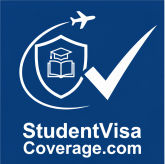Why International Students Need U.S. Health Insurance
Avoid High Medical Costs
The U.S. healthcare system is one of the most expensive in the world. A single emergency room visit can cost $3,000-$10,000. Student visa health insurance protects you from unexpected medical bills that can run into tens of thousands of dollars.
Meet J-1 Visa Federal Requirements
J-1 visa holders are required by U.S. federal law to maintain health insurance with minimum coverage of $100,000 per incident, $50,000 medical evacuation, and $25,000 repatriation. We offer J-1 compliant plans.
Satisfy F-1 University Insurance Mandates
Nearly all U.S. colleges and universities require international students on F-1 and M-1 visas to have health insurance to register for classes. Find plans that meet university waiver requirements.
Student Visa Health Insurance Requirements Explained
J-1 Visa Insurance: Federal Law Requirements
The U.S. Department of State mandates that all J-1 exchange visitors maintain continuous health insurance coverage meeting these specific minimums:
- $100,000 minimum medical benefits per accident or illness
- $50,000 emergency medical evacuation to home country
- $25,000 repatriation of remains
- Maximum deductible of $500 per accident or illness
Our J-1 visa insurance plans are fully compliant with Department of State regulations. Get proof of coverage for your sponsor.
F-1 & M-1 Visa Insurance: University Requirements
While not mandated by federal law, your university sets specific health insurance requirements for F-1 and M-1 students. Most schools provide a default plan but allow you to waive it with a comparable alternative.
OPT Health Insurance for F-1 Students 💼
Optional Practical Training (OPT) allows F-1 visa holders to work in the U.S. after graduation. When you transition from student to employee, your health insurance coverage changes. Here's what F-1 OPT students need to know about maintaining health insurance.
OPT Insurance is Your Responsibility
Once you begin OPT, your university is no longer responsible for providing health insurance. You will likely lose coverage from your school's student plan upon graduation. Finding and maintaining OPT health insurance becomes your personal responsibility as an F-1 visa holder.
Why OPT Students Need Coverage
Working on OPT without health insurance in the U.S. creates major financial risk. A single accident or illness can result in medical bills exceeding $50,000. OPT insurance protects your health and savings as you begin your career in the United States.
OPT Health Insurance Options
F-1 OPT students have several options: extend your student plan if allowed, enroll in employer-sponsored insurance, or purchase a private OPT insurance plan. We offer private plans specifically designed for OPT participants between jobs or with employers who don't offer benefits.
Ready to Find Your Plan?
Whether you're studying or starting your career on OPT, our process helps you enroll online in minutes. Get the protection you need and focus on your future.
Frequently Asked Questions
Most student health plans are PPO (Preferred Provider Organization) plans. This means the insurance company has a special network of doctors, hospitals, and clinics that have agreed to provide services at a lower, pre-negotiated price.
- In-Network: These are the "preferred" providers in your plan's network. Using them will always be your most affordable option.
- Out-of-Network: These are providers who do not have a contract with your insurance. You have the flexibility to see them, but your costs will be significantly higher.
A Real-World Example: Seeing a Doctor
Imagine you wake up with a sore throat and need to see a doctor.
✅ The Smart Choice (In-Network): You visit your insurance company's website and use their "Find a Doctor" tool. You find an "in-network" urgent care clinic near you. Because the clinic is in-network, you pay a small co-pay (e.g., $40) and the insurance covers the rest of the discounted bill. Your costs are low and predictable.
❌ The Expensive Mistake (Out-of-Network): You go to the first clinic you see without checking if it's in your network. The clinic is "out-of-network," so they charge a higher, non-discounted rate. Your insurance plan will cover a much smaller percentage of the cost, and you will be responsible for a much larger bill.
Key Takeaway: Always check the insurance provider's website to find an in-network doctor or hospital BEFORE you receive care (except in a true life-threatening emergency).
Think of it as a two-step process for sharing medical costs with your insurance company. You must complete Step 1 before Step 2 begins.
Step 1: The Deductible. This is a fixed dollar amount you must pay out-of-pocket for medical services first. If your plan has a $500 deductible, you are responsible for paying the first $500 of your covered medical bills.
Step 2: Coinsurance. This is a percentage-based sharing of costs that starts *after* you have paid your full deductible. A common coinsurance is 80/20. This means the insurance company pays 80% of the remaining bill, and you pay 20%.
Example: Let's say you have a $2,500 medical bill, a $500 deductible, and 80/20 coinsurance.
- You pay the first $500 (to meet your deductible).
- This leaves a remaining balance of $2,000.
- Your 20% coinsurance share of the remaining balance is $400 ($2,000 x 0.20).
- Your total out-of-pocket cost for the bill would be $500 + $400 = $900.
In most cases, no. Standard travel insurance policies typically do not meet the specific benefit levels required by the U.S. Department of State for J-1 visas or by U.S. universities for their school waivers. It's crucial to get a U.S.-based, compliant plan.
Instantly. Once you complete your enrollment online, you will typically receive a confirmation email with your insurance ID card and a visa compliance letter within minutes. You can forward this directly to your school's international student office.
